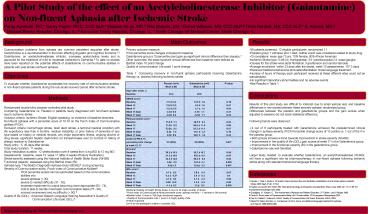References PowerPoint PPT Presentation
1 / 1
Title: References
1
A Pilot Study of the effect of an
Acetylcholinesterase Inhibitor (Galantamine) on
Non-fluent Aphasia after Ischemic Stroke Parag
Agnihotri, MD, Carey Payne, MCD, CCC-SLP,
Mukesh Ahuja, MD, Rita Shapiro, DO, Daniel
Williams, MS, CCC-SLP, Tricia Hardiek, MS,
CCC-SLP, S. Ahmad, MD, Michael Reese
Hospital, Chicago, IL, Advocate Trinity
Hospital, Chicago, IL, North Chicago VA Medical
Center, North Chicago, IL
Background
Results
Main Outcomes
Communication problems from aphasia are common
persistent sequelae after stroke. Acetylcholine
is a neurotransmitter in the brain affecting
linguistic and cognitive functions.1,2
Galantamine, an acetylcholinesterase inhibitor,
increases acetylcholine levels and is approved
for the treatment of mild to moderate Alzheimers
Dementia.3 To date no studies have been reported
on the potential effects of Galantamine on
communicative abilities in patients with
post-stroke nonfluent aphasia.
- 36 patients screened, 12 eligible participants
randomized 11. - Placebo group 1 withdrew and 1 died neither
event was considered related to study drug. - 10 completers mean age 73 yrs, 70 female, 80
African American. - Ischemic Stroke type 5 left (lt.)
frontoparietal, 3 lt. parietooccipital,2 lt.
basal ganglia. - Causes for the stroke were atrial fibrillation,
hypertension and carotid stenosis. - Average enrollment within 23 days after the
stroke, week 13 assessments 107.3 days - Received traditional behavioral
stimulation/facilitation model language
treatment. - Number of hours of therapy each participant
received at these different sites could not be
standardized. - No significant laboratory abnormalities and no
adverse events. - See Results in Table 1
Primary outcome measure PICA percentile score
changes compared to baseline. Galantamine group
a 15 percentile point gain as significant
clinical difference than placebo.7 Other
outcomes the least important clinical
differences from baseline were defined as
Barthel Index 10 point change Quality of
communication Life scale 1 point change.
Table 1 Comparing recovery in non-fluent aphasic
participants receiving Galantamine therapy vs.
placebo following ischemic stroke.
Objectives
To evaluate whether Galantamine accelerates the
recovery rate of communicative abilities in
non-fluent aphasia patients during the sub-acute
recovery period after ischemic stroke.
Conclusions
Methods
Randomized double-blind placebo-controlled pilot
study. Comparing Galantamine vs. Placebo in
patients newly diagnosed with non-fluent aphasia
due to ischemic stroke. Inclusion criteria
Ischemic Stroke, English-speaking, no evidence of
baseline dementia. Non-fluent aphasia with a
percentile score of 10-70 on the Porch Index of
Communicative abilities (PICA). Exclusion
criteria hemorrhagic stroke, brain stem stroke,
a terminal medical condition with life expectancy
less than 6 months, medical instability, or prior
history of dementia of any type based on history
or medical records, any major psychiatric
illness, ongoing alcohol or drug abuse,
significant hepatic dysfunction (or transaminases
over 2x normal) or history of allergic reaction
to Galantamine. Study entry 5- 45 days after
stroke. Total study duration 17 weeks. Study
medication duration 12 weeks titration over 8
weeks from 4 mg BID to 12 mg BID Assessments
baseline, week 13, week 17 (after 4 weeks off
study medication). Stroke severity assessed using
the National Institute of Health Stoke Scale
(NIHSS) Functional capacity assessed using the
Barthel Index (BI). Aphasia type The Boston
Diagnostic Aphasia Exam (BDAE)4 during screening
Severity of Communicative ability Porch Index
of Communicative Abilities5 PICA percentile
scores can be subdivided based on the
communicative abilities into severe aphasia (lt
30), severe to marked difficulty (31 -
50), moderate impairment to output becoming more
appropriate (50 - 74), mild to able to handle
most basic communication tasks (75 - 90),
minimal involvement and no difficulty (gt 90).5
Quality of life (QOL) American Speech-Language
Hearing Association's Quality of
Communication Life scale (QCL).6
- Results of this pilot study are difficult to
interpret due to small sample size and baseline
differences in raw scores between these severely
aphasic randomized group. - Differences between the placebo and galantamine
groups and the gain scores when adjusted to
baseline did not reach statistical difference. - Following trends were observed
- 4 out of 6 participants treated with Galantamine
achieved the predetermined clinical change in
aphasia severity (PICA Percentile change score of
15 points) vs. 1 out of the 4 in the placebo
group. - Both groups showed a trend towards improvement in
stroke severity (NIHSS). - Improvement in the quality of life (QCL) gain
scores at week 17 in the Galantamine group - Improvement in the functional capacity (BI) in
the galantamine group. - Galantamine was well tolerated.
- Larger study needed to evaluate whether
Galantamine, an acetylcholinesterase inhibitor,
will have a significant role as pharmacotherapy
in non-fluent aphasia following ischemic stroke
along with standard behavioral language therapy.
References
1.Kessler J, Thiel A, Karbe H .Piracetam improves
blood flow and facilitates rehabilitation of post
stroke aphasic patients. Stroke 2000 Sept
31(9) 2112-6 2.Hughes JD,Jacobs DH, Heilan KM.
Neuropharmacology and linguistic neuroplasticity.
Brain Lang. 2000 Jan 71(1) 96-101 3.Galantamine
package insert 2003 4.Goodglass, H., Kaplan, E.
The Assessment of Aphasia and Related Disorders,
2nd Edition. Lea Febiger 1983. 5.Porch,B
Porch Index of Communicative Ability Vol.2 Fourth
edition. PICA programs Albuquerque,2001 . 6.Paul
D, Frattali C, Holland A, ASHA Quality of
Communication Life Scale, Rockville, ASHA, 2004.
7.Wertz RT, Weiss DG,Aten JL. Comparison of
clinic, home, and deferred language treatment for
aphasia. Arch Neurol.198648653-658
?National Institute of Health Stroke Scale 0
(low) to 42 (high) severity of stroke Porch
Index of Communicative Ability percentile score
aphasia severity -- 1 (severe) to 99 (normal)
?Barthel Index 0 (low) to 100 (high) functional
capacity Quality of Communication Life 1 (low)
to 5 (high) quality of life Fisher exact test
n3 as one participant unable to complete QCL
Research Funding by
Ortho-McNeil Neurologics, Inc.

